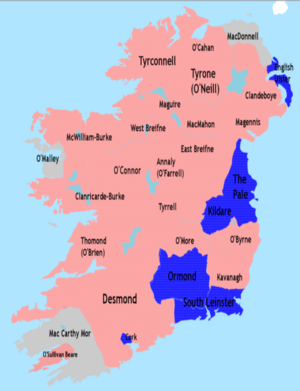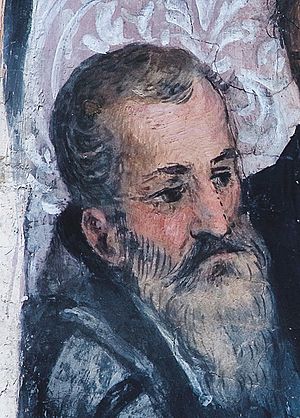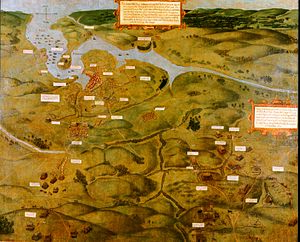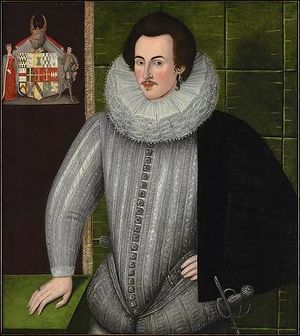Nine Years' War (Ireland) facts for kids
Quick facts for kids Nine Years' War |
|||||||
|---|---|---|---|---|---|---|---|
| Part of the Tudor conquest of Ireland and the European wars of religion | |||||||
 Ireland in 1600 showing approximate Irish alliance control at its height (red), and English control (blue) |
|||||||
|
|||||||
| Belligerents | |||||||
| Commanders and leaders | |||||||
| Irish lords: Hugh O'Neill Hugh Roe O'Donnell Hugh Maguire (DOW) Brian O'Rourke Fiach McHugh O'Byrne † Richard Tyrrell (POW) James Fitzthomas Cormac MacBaron O'Neill Donal Cam O'Sullivan Beare Spanish leaders: Martín de Padilla Juan del Águila Diego Brochero Alonso de Ocampo Pedro de Zubiaur full list... |
English leaders: William Fitzwilliam Henry Bagenal † John Norreys (DOW) William Russell Robert Devereux (Earl of Essex) Charles Blount (Lord Mountjoy) Thomas Norreys (DOW) George Carew Henry Docwra Arthur Chichester Irish loyalists: Niall Garve O'Donnell Donogh O'Brien Cahir O'Doherty Earl of Clanricard full list... |
||||||
| Strength | |||||||
|
~21,000, including: |
~5–6,000 (before 1598) ~18,000 (after 1598) |
||||||
| Casualties and losses | |||||||
| ~100,000 soldiers and Irish civilians (the vast majority died due to famine) | ~30,000 soldiers (though more died from disease than in battle) and hundreds of English colonists | ||||||
| Total dead: 130,000+ | |||||||
The Nine Years' War, also known as Tyrone's Rebellion, was a major conflict in Ireland from 1593 to 1603. It involved an alliance of Irish leaders, mainly Hugh O'Neill and Hugh Roe O'Donnell, fighting against English control. This war was a direct response to England's efforts to fully conquer Ireland.
The fighting started in the northern parts of Ireland but soon spread across the entire island. The Irish alliance won important battles, like the Battle of Clontibret (1595) and the Battle of the Yellow Ford (1598). However, the English, with help from their Spanish allies, won a key victory at the siege of Kinsale (1601–02). The war officially ended with the Treaty of Mellifont in 1603. After their defeat, many Irish lords left Ireland in an event called the Flight of the Earls (1607), hoping to get support for a new uprising. This marked the end of traditional Gaelic Ireland and led to the Plantation of Ulster, where English and Scottish settlers moved into Irish lands.
This war was the biggest conflict England fought during the time of Queen Elizabeth I. At its peak, the English army in Ireland had over 18,000 soldiers. This was a larger force than the English army helping the Dutch during the Eighty Years' War.
Contents
Why the War Started
The Nine Years' War began because of growing tensions between the powerful Irish lord Hugh O'Neill and the expanding English government in Ireland. England wanted to control the entire island, not just the area around the Pale. O'Neill brought together other Irish groups who were unhappy with English rule. Some Catholics also joined him because they opposed the spread of Protestantism in Ireland.
The Rise of Hugh O'Neill
Hugh O'Neill came from the strong O'Neill family, who ruled much of Ulster in northern Ireland. He was recognized by the English Crown as the Earl of Tyrone. O'Neill fought against other Irish leaders to gain full control of his family's lands. He also made sure his own people were loyal to him.
O'Neill built a strong army. He hired Scottish soldiers known as Redshanks and Irish mercenaries. He also made his own tenants serve in his army. To equip his soldiers, O'Neill bought muskets, ammunition, and pikes from Scotland and England. From 1591, O'Neill's ally, Hugh Roe O'Donnell, contacted Philip II of Spain for military help. They appealed to Spain because they shared the Catholic faith and had a common enemy in England. With Spain's help, O'Neill could arm and feed over 8,000 men. This made him very powerful and ready to fight against English attempts to control Ulster.
English Expansion into Ulster
By the early 1590s, the English government wanted to bring northern Ireland under its control. They planned to appoint an English governor, Henry Bagenal, to enforce English law and appoint sheriffs. O'Neill had married Bagenal's sister, Mabel, against her brother's wishes, which created a lot of bad feeling between them.
In 1591, the English broke up the MacMahon lordship in Monaghan when its leader resisted an English sheriff. This policy was then applied to other Irish territories. Any attempt to do the same in O'Neill's and O'Donnell's lands was sure to lead to war.
Ulster had natural defenses that made it hard for English forces to enter. There were only two main land routes from the south: at Newry in the east and Sligo in the west. The land in between was mostly mountains, forests, and bogs. The English also had a small settlement near Carrickfergus, but the terrain there was also difficult. The Lough Neagh and river Bann created a natural barrier. Adding to the English problems, Scottish clans were helping O'Neill with soldiers and supplies.
War Begins
In 1592, Hugh Roe O'Donnell forced an English sheriff out of his territory. In 1593, Maguire, with help from O'Neill's brother, resisted the English sheriff in Fermanagh. After the sheriff was expelled, Maguire raided northern Connacht, burning villages.
English forces, led by Sir Henry Bagenal, marched into Fermanagh to stop Maguire and his allies. O'Neill initially helped the English, hoping to be made the English governor of Ulster. However, Queen Elizabeth I feared that O'Neill wanted to become a "Prince of Ulster" and take over her authority. She refused to give him any position that would give him power over Ulster.
When it became clear that Henry Bagenal would become the governor, O'Neill realized that war was unavoidable. In February 1595, he openly rebelled, attacking the Blackwater Fort, which guarded an important bridge.
Later in 1595, O'Neill and O'Donnell asked King Philip II of Spain for help and offered to become his loyal subjects. A truce was made in late 1595, and Maguire surrendered in April 1596. O'Neill even promised to explain his actions to the Queen. But when three Spanish envoys arrived in 1596, promising men and supplies, any chance of peace ended. An unsuccessful Spanish fleet sailed in 1596, and the war in Ireland became part of the larger Anglo-Spanish War.
Irish Victory at Yellow Ford

The English government in Dublin Castle was slow to understand how serious the rebellion was. After peace talks failed in 1595, English armies tried to enter Ulster but were pushed back by O'Neill's well-trained soldiers. After a defeat at the Battle of Clontibret, more English attacks failed. At the Battle of the Yellow Ford in 1598, about 2,000 English soldiers were killed. They were attacked while marching to Armagh. The remaining English troops were surrounded but negotiated a safe exit from Armagh. O'Neill's enemy, Sir Henry Bagenal, was leading the English army and was killed. This was the biggest defeat the English army had ever suffered in Ireland.
This victory caused uprisings across Ireland. O'Neill sent his soldiers and supporters to help. He appointed new leaders, like James Fitzthomas Fitzgerald as the Earl of Desmond. In Munster, about 9,000 men joined the rebellion. The Munster Plantation, where English settlers had moved, was badly hit, and many settlers, including the poet Edmund Spenser, fled.
Most fortified cities and towns in Ireland stayed loyal to the English government. O'Neill tried to convince the people of the Pale to join his rebellion, appealing to their Catholic faith. However, most of the Old English (descendants of earlier English settlers) remained against their traditional Gaelic enemies.
Earl of Essex's Command
In 1599, Robert Devereux, 2nd Earl of Essex arrived in Ireland with over 17,000 English troops. He decided to secure the south of the country first before attacking Ulster. This spread out his forces, and he faced many problems. He spent most of his time waiting for ships and supplies that never arrived. His military expeditions were disastrous, especially one crossing the Curlew mountains, where O'Donnell defeated his forces at the Battle of Curlew Pass. Thousands of his soldiers died from diseases like typhoid and dysentery in unhealthy garrisons.
When Essex finally went to Ulster, he met with O'Neill and agreed to a truce. This truce was criticized in London, even though Queen Elizabeth later said it was helpful. Essex then left Ireland for London without the Queen's permission and was later executed after trying to take control of the court.
Lord Mountjoy replaced Essex in Ireland. Mountjoy proved to be a much better commander, partly because he received all the support Essex had lacked. Two experienced commanders, George Carew and Arthur Chichester, were given commands in Munster and Ulster.
In November 1599, O'Neill sent Queen Elizabeth a list of his terms for peace. He asked for a self-governing Ireland, return of lands and churches, freedom of movement, and a strong Catholic identity. He accepted English rule but asked that the English viceroy be a high-ranking official. Queen Elizabeth's adviser, Sir Robert Cecil, called O'Neill's demands "Ewtopia" (meaning an impossible dream).
Rebellion Ends in Munster
George Carew, the English Lord President of Munster, mostly crushed the rebellion there by mid-1601. He used a mix of negotiation and force. By summer 1601, he had recaptured most of the main castles and scattered the Irish forces. He made a deal with Florence MacCarthy, a key Gaelic Irish leader, allowing MacCarthy to stay neutral. This let Carew focus on attacking James Fitzthomas Fitzgerald, who led the main rebel force.
In summer 1600, Carew attacked Fitzthomas's forces. The English defeated them at Aherlow. By November, Carew reported that he had killed 1,200 rebels and received the surrender of over 10,000. Carew also weakened Florence MacCarthy by getting a rival MacCarthy chieftain to join the English.
In June 1601, James Fitzthomas was captured. Soon after, Carew arrested Florence MacCarthy during negotiations. Both Fitzthomas and MacCarthy were imprisoned in the Tower of London. Most other local lords surrendered once their main leaders were captured. O'Neill's hired soldiers were forced out of Munster.
Battle of Kinsale and the Rebellion's Collapse
Mountjoy managed to enter Ulster by landing troops at Derry under Henry Docwra and at Carrickfergus under Arthur Chichester. Docwra and Chichester, helped by Niall Garve O'Donnell (a rival of Hugh Roe), destroyed the countryside. They aimed to cause a famine and kill civilians to weaken the rebels.
Their plan was that without food or people, the rebels could not feed themselves or find new fighters. This strategy quickly began to work, forcing the Ulster chiefs to stay in Ulster to defend their own lands.
Although O'Neill managed to stop another English attack by Mountjoy at the Battle of Moyry Pass in 1600, his situation was becoming desperate.
In 1601, the long-awaited Spanish help finally arrived. About 3,500 Spanish soldiers landed at Kinsale, Cork, at the southern tip of Ireland. Mountjoy immediately surrounded them with 7,000 English soldiers. O'Neill, O'Donnell, and their allies marched south to trap Mountjoy's forces, who were suffering from hunger and disease, between their armies and the Spanish. During their march south, O'Neill destroyed the lands of those who did not support him.
The English army might have been defeated by hunger and sickness, but the battle was decided in their favor at the Battle of Kinsale. On January 5/6, 1602, O'Donnell decided to attack the English, against O'Neill's advice. The Irish chiefs, planning a surprise attack, were themselves surprised by an English cavalry charge. This led to a complete defeat of the Irish forces. The Spanish in Kinsale surrendered after their allies were defeated.
The Irish forces retreated north to Ulster to regroup. Many more Ulstermen died during the freezing and flooded retreat than in the actual battle. The last rebel stronghold in the south was captured at the siege of Dunboy by George Carew.
Hugh Roe O'Donnell went to Spain to ask for another Spanish landing, but he failed. He died in 1602, possibly poisoned by an English agent. His brother took over leadership of the O'Donnell clan. Both he and Hugh O'Neill were forced to use guerrilla tactics, fighting in small groups. Mountjoy, Docwra, Chichester, and Niall Garbh O'Donnell swept through the countryside. The English used harsh "scorched earth" tactics, burning crops and killing livestock. This caused many civilians to die from direct attacks and famine.
War's End
In 1602, O'Neill destroyed his capital at Dungannon as Mountjoy's forces approached, and he hid in the woods. Mountjoy symbolically destroyed the O'Neills' inauguration stone at Tullaghogue. Famine soon hit Ulster because of the English scorched earth strategy. O'Neill's sub-lords began to surrender. Rory O'Donnell, Hugh Roe's brother, surrendered at the end of 1602.
However, O'Neill held out in the dense forests of Tir Eoghain until March 30, 1603. He surrendered to Mountjoy on good terms, signing the Treaty of Mellifont. Queen Elizabeth I had died on March 24, just before the treaty was signed.
Although the war officially ended with the Treaty of Mellifont, the final battles were fought in April 1603 during the English invasion of West Breifne. This was the last Irish kingdom holding out. It was ruled by Brian Óg O'Rourke, a key Irish leader. He did not get any benefits from the treaty because his half-brother had fought with the English. After a twelve-day siege, English forces brought West Breifne, and thus all of Ireland, under English control on April 25, 1603.
Aftermath of the War
The new King of England, James I, gave good terms to the rebel leaders. He hoped to finally end the costly war that had almost bankrupted England. O'Neill, O'Donnell, and other surviving Ulster chiefs received full pardons and got their lands back. They had to give up their Irish titles, their private armies, and their control over their people. They also had to swear loyalty only to the English Crown. In 1604, Mountjoy declared an amnesty for all rebels. England could not afford to continue the war. The war in Ireland cost over £2 million, nearly bankrupting the English treasury by 1603.
Irish records claim that as many as 60,000 people died in the Ulster famine of 1602–03 alone. The total Irish death toll might have been over 100,000. At least 30,000 English soldiers died in Ireland during the war, mostly from disease. So, the total number of deaths was certainly over 100,000 people.
Even though O'Neill and his allies received good terms, the English authorities never fully trusted them, and the feeling was mutual. In 1607, O'Neill, O'Donnell, and other Gaelic lords from Ulster left Ireland in what is known as the "Flight of the Earls". They planned to get support from a Catholic power in Europe, especially Spain, to restart the war. However, they could not find any military help.
Spain had signed a peace treaty with England in 1604 and did not want to start fighting again. Also, a Spanish fleet had just been destroyed by the Dutch in 1607. In 1608, Sir Cahir O'Doherty, who had fought for the English, started O'Doherty's Rebellion by attacking and burning Derry. O'Doherty was defeated and killed, and his rebellion quickly ended.
In 1608, the lands of the absent earls were taken by the English because they had tried to start another war. These lands were soon settled by English and Scottish people in the Plantation of Ulster. The Nine Years' War was therefore a very important step in the English and Scottish colonization of Ulster.
See also
- Grace O'Malley
- List of Irish uprisings
- Tudor conquest of Ireland
- Nine Years' War
- Anglo-Spanish War (1585–1604)
- Tudor period, perspective from English history




